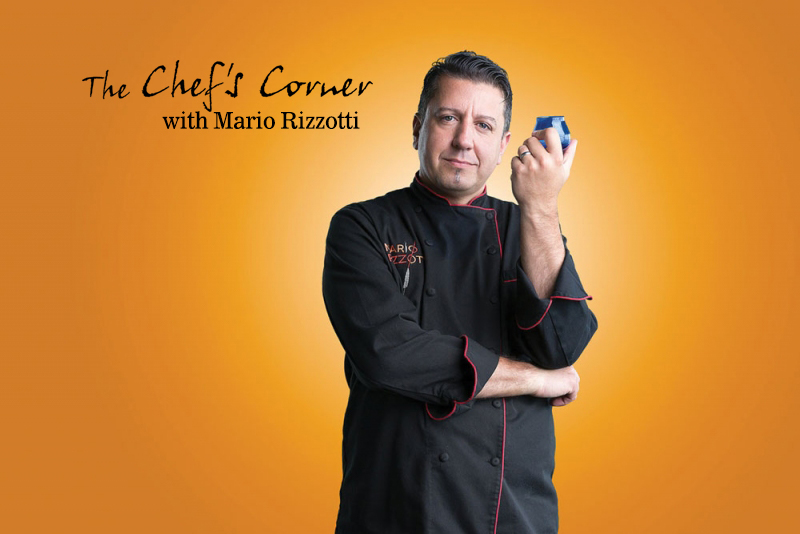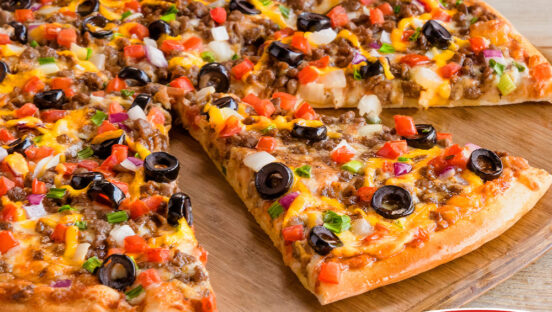- In this 2018 interview with Mario Rizzotti, the Iron Chef America judge reflected on his career and how getting fired from one job made him a success.
- Rizzotti, who was born in Rome, also talked about “authentic Italian” versus “American-Italian” cuisine and named some of his favorite ingredients to work with.
The 1980s was an era of excess in America. It translated to all aspects of our lives: possessions, wealth, the number of different hair gels we owned, even our pizzas. We started piling on the toppings to get more bang for our buck. But, luckily, the world has since realized that sometimes less is more, whether in our personal lives or personal pizza diets. Harkening back to the early days of pizza, a food invented to feed the masses cheaply, Americans are grasping simplicity once again. Mario Rizzotti of Chicago, famed culinary judge of Iron Chef America, emcee and brand ambassador, talked to PMQ’s Brian Hernandez about the importance of simplicity in recipes and quality ingredients. We also learned a little more about how Mario was able to climb through the ranks of culinary stardom to become the well-known figure he is today and why it’s important to source authentic Italian ingredients before you call yourself a purveyor of “true Italian pizza.”
(Editor’s note: PMQ’s Brian Hernandez interviewed Mario Rizzotti in early 2018. We’re revisiting it here because Rizzotti shared a lot of wisdom that’s more relevant today than ever. The interview has been condensed and edited for clarity and conciseness. Scroll down to watch the full video or click here.)
Brian: Thank you so much for taking the time to sit with us today, Chef Mario. I really appreciate it.
Mario: No problem, Brian, but I would appreciate to be called an Italian culinary expert, since I never went to culinary school, and the only ones who can be called “chef” are culinary school graduates. I always say, just call me Mario, because the only one you can call “Chef,” in my opinion, is Chef Boyardee.
Brian: So, what is your earliest pizza memory? The first that comes to mind when you think of pizza?
Mario: I can tell you, Brian, I think I got pizza before I got milk. Being born and raised in Italy, it is one of the main foods everyone is making. Either your mama is making it or your neighbors are making it. Or you go out and buy it by the slice, like I used to do, al taglio style. I have to be honest: As soon as I was able to bite on something, one of the first foods would have been pizza, no doubt about it.
I think I’m lucky because I was born in Italy, the home of pizza. So, there were no worries on where to find it or what kind of pizza it would be. That’s why I try to tell everybody, you’re lucky if you’re born in Italy. You can always find something new in pizza every day. I’m pretty sure we’ve had Roman-style pizza there since the Roman Empire, if you know what I mean, but it’s always changing.
Brian: So, you are from Rome originally?
Mario: I was born and raised in Rome, but I also grew up in Gaeta, which is a little south of Rome. Gaeta is very well-known because it has a beautiful clean, one-mile stretch of beach. It’s also the home of Gaeta olives, which, as any of you pizzaiolos know, are great olives to use on your pizzas.
Brian: How did you get started in the restaurant industry? What was your first job?
Mario: When I came [to the U.S.] 23 years ago, I started to wash dishes in a small restaurant in Glenview, Illinois, called Trattoria Ginotto. That was my first place to work. I started working there because I was on vacation visiting a friend, and he kept telling me people weren’t showing up for shifts and asking if I could help out. So that’s how I got my job there: from coming here on vacation and filling in for employees. That’s also where I got the passion for authentic Italian cuisine, because, as you know, we have a lot of great American-Italian cuisine in this country, as well as American-Italian pizza, but we don’t have as many authentic Italian places in all the 50 states.
Brian: Now, wait, we have a lot of authentic Italian places.
Mario: Yes, but not actually authentic. It’s only in the name. As you know, in Italy, there is no fettucine Alfredo, chicken vesuvio, meatballs on top of pasta, Italian beef. This is why I took it to heart to start traveling around the country now to try to educate people to understand the difference between, let’s say, a Ferrari…and a red car.
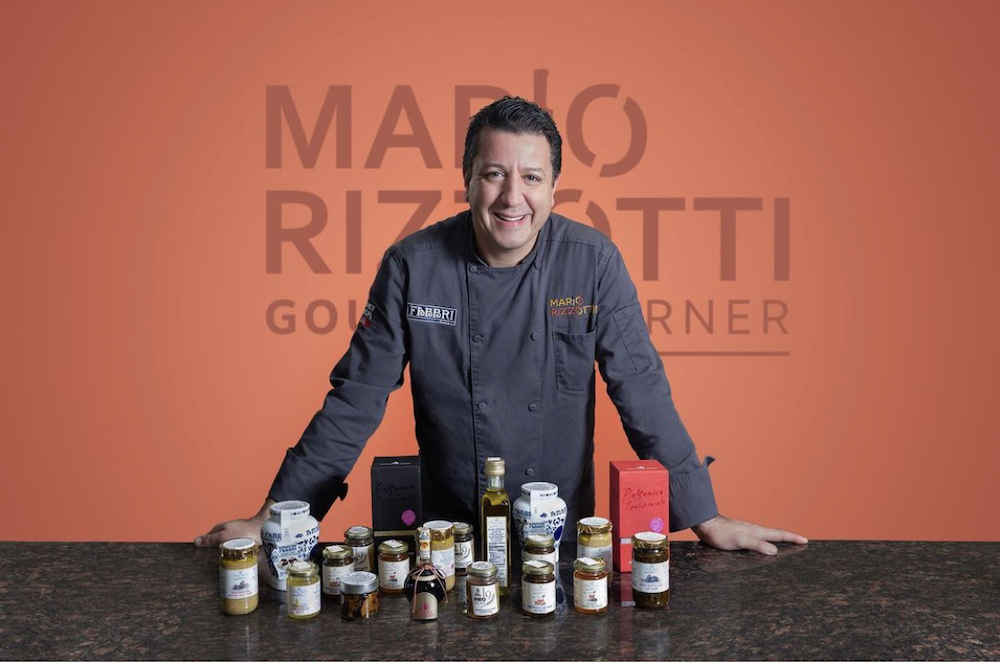
Mario Rizzotti / Instagram
Brian: I get it. The same way there are no fortune cookies in China. It’s a completely Americanized version of an ethnic cuisine. What was the worst pizzeria/restaurant job you had when you first came over here?
Mario: I believe that, good or bad, all of these positions led me to where I am in my life, so talking bad about them is not going to help me. So, with that, I would like to say, “Thank you for having such a dirty kitchen, and thank you for forcing me to have to leave your place and go to the next place, which opened up the door for me to be where I am right now!” Which is being a judge on Iron Chef and an Italian culinary expert.
I wish, at times, people could change the entrance of their restaurants from the front door to the back door through the kitchen. Then, you could see if the kitchen is really clean and treated with as much, actually more respect, than the front of the house is. It would keep all the kitchens far cleaner.
Brian: That’s a great philosophy for restaurateurs: “Expect every customer to enter through the kitchen.” On the other side of this coin, what is the best restaurant job you’ve had?
Mario: The restaurant jobs that I went through, I consider all of them the best, and I’ll tell you why. If it wasn’t for each one of them, again, I wouldn’t be where I am right now. Years ago, I worked at Gordon, a fine dining establishment in Chicago, under Gordon Sinclair. It was a great place. I learned a lot about how to run a restaurant. But probably the best of the best, I can say, is when I got fired from a restaurant on Taylor Street, and that actually opened up my doors to a new job at a food company, which led to my work on Iron Chef because of my passion and my knowledge about Italian ingredients.
Brian: So, your best job is the one you got fired from, that led you to the path that you’re on now?
Mario: Well, number one, that’s the only one I got fired from. Number two, it was for a mistake they discovered later. But I said, “You know what? Thank you for letting me know it was a mistake, but also thank you for firing me because if it wasn’t for you, I wouldn’t be where I am right now.”
Brian: What were some other stops along the way, after that firing, in your path to the Food Network?
Mario: I did work at Academia Barilla for several years at one point. There, I developed knowledge for authentic Italian ingredients. As you know, there is a big difference between what’s real Italian and what’s fake, and my job right now is to travel the country and educate people on the difference. To be true Italian, it must state the three magic words, which are “Product of Italy.” If it only says “made in Italy,” “packed in Italy,” or “imported from Italy”…I’m sorry to say, there is not much “Italian” in there.
Now, one day I was doing a party at Chef Art Smith’s house, who used to be the personal chef for Oprah Winfrey, and I was introduced to this gentleman that happened to be the vice president of the Food Network. And because of my passion, they wanted me to try an episode of Iron Chef, and here we are: I’m a judge on Iron Chef America!
Brian: At this point, what is the biggest success you’ve had, business-wise, that would translate to our readers’ businesses?
Mario: The number one thing people can apply to their pizzerias, or really any business, is never let go. I mean, I was a dishwasher 23 years ago, but I wasn’t planning on remaining a dishwasher. Number two, there is one ingredient never listed in any recipe, but you will see it in my new cookbook [coming out in 2019], and that is passion. If you are not passionate about what you do, it really will not be a representation of yourself. If you do it just because you have to do it, it is never going to taste as good as when it’s coming from your heart.
Brian: What’s one mistake you’ve made while growing your business and brand over the years that someone can apply to their pizzeria?
Mario: So, pizza-wise, and actually for any business, I would tell people, when you have your day off, take that day off. It’s a mistake I made over and over again in my own business. If you have a day off, stay home, spend it with your family and shut off your phone. Hopefully, you’ve done a great job building the business and training employees. If you have a day off and are always worried that something will go wrong if you’re not there, the number one problem is that you could not find the right help. Number two, unfortunately, is they were probably not trained right. But the biggest tip is, take your time off, because those moments with your family, your kids, your dog…they are not going to come back.
Brian: What inspires your recipes?
Mario: First of all, I just want to say this out loud: I am tired of hearing people say, “This is my recipe.” You think that, over 2,017 years, no one has done it before you? It is not your recipe, it is probably a recipe you put your own twist on. Therefore, I like to come up with recipes that are close to my heart, my roots and my origin. I try to help people understand that simplicity is the key to my recipes. My mom used to say, “Six ingredients are the most you can do for Italian cuisine. But be careful, because six ingredients, are already two too many.” This translates to pizza. When I go into a pizzeria that has too many toppings on a pie, I’m asking, “What are you planning to taste in this? With too many ingredients, you are not sure what flavors you are supposed to be tasting.”
Brian: If there is one thing you would tell these operators to strive for, besides “less is more” and quality ingredients, what would it be?
Mario: I would say, instead of putting “Italian Pizza” on your front door, put “Italian-Style Pizza” or “Italian-Inspired Pizza,” because here in the U.S., it might not be the same. It’s not because the pizzaiolo is not good, but it’s the difference in ingredients.
Brian: Great advice, Mario. This brings us to the “Scott Wiener Lightning Round,” so named because he was the first poor soul to suggest it and be subjected to it. I will give you three ingredients that I have not mentioned before, and you must come up with a recipe or pie you would put them on. You ready?
Mario: I have been waiting for this. Let’s go!
Brian: OK, here we go: Capers.
Mario: Definitely they go on a nice pizza. You can use them with some arugula. You can actually make a bruschetta pizza. You can mix the fresh tomatoes and capers and top the pizza with that once you’re done. It’s a very, very good ingredient. I remember me and my brother being in charge of going to pick the capers when we were young. They are a great ingredient, a little misunderstood like anchovies, but one that retains that saltiness. So, let’s invent an “Italian-inspired” pizza right now called the Pizza Bruschetta with chopped tomatoes and capers. But it’s simple, just these few ingredients. The more you put in, the harder it is to discern tastes. Like with fusion cuisine: I always say, “Fusion is confusion.”
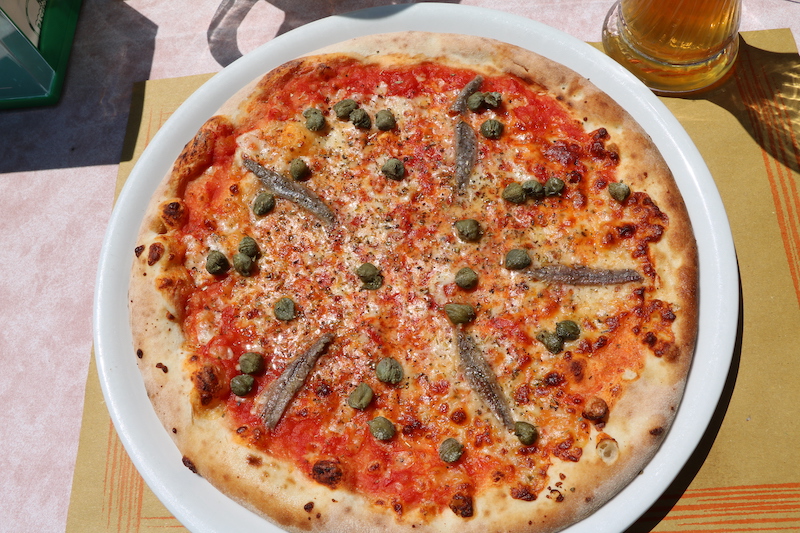
Getty Images
Brian: Okay, this one might take you a second: Broccoli rabe.
Mario: Broccoli Rabe…hmmm. That’s definitely a pie with fresh mozzarella and broccoli rabe on top. It’s a style you find a lot on Naples. I would put the mozzarella, the broccoli rabe, and I would also add anchovies. And you know what? I’m going to add capers too.
Brian: Let’s see if we can trip you up in the third and final round. This one is probably more Americanized as a pizza ingredient: corn.
Mario: Ciao! (Gets out of his chair and walks away).
Brian: Ooohh, I lost him. I’m sorry, folks, that was Mario Rizzotti of Chicago…oh, it seems he’s coming back!
Mario: You know what I’d do? The worst-case scenario, I’d mix it in the dough and create something new that has nothing to do with Italian pizza. Making something like a sweet-corn pizza dough. Or, second try, we would do an Italian-style pizza dough, and use some arugula and corn on the top with some extra virgin olive oil at the end just to finish it up.
Brian: I love the idea of incorporating it into the crust. Very unique. But I love both of those ideas. You did spectacular in the “Scott Wiener Lightning Round.”
Mario: Thank you. And when you visit in Chicago, I will have a new pizza for you try: the Capers, Broccoli Rabe and Corn pizza.
Brian: Don’t forget the anchovies!
Mario: I never forget the anchovies.
Brian: What was the best dish you have ever judged on Iron Chef?
Mario: I’d have to say the best dishes were the ones made in the battle with Parmigiano-Reggiano when it was on the show. They were definitely the best I tried in a long time. That ingredient came around twice, the second time with different chefs, and all the dishes from both times were fantastic. I remember Mario Batali put some pasta into this big wheel of Parmigiano-Reggiano and lit it on fire with some Grappa, and the flavor profiles that came out of that were amazing.
Brian: What about the worst dish?
Mario: The worst, and I’m sorry to my good friend Emma Hearst [for saying this]. She was the youngest competitor at the time to be on Iron Chef. She is a very talented chef, and she was up against Michael Simon at the time, but, burrata on top of mussels? (shakes head) It was no good for me, I’m sorry. But I talked to her and let her know why I didn’t like it. And it is just my opinion. She made the burrata from scratch, she made the mozzarella from scratch, so there was a lot to admire about the dish. Maybe you love burrata on your mussels, I don’t know. But as the judge, that was my judgement. But even the worst in that arena are better than most others out there today.
Brian: Well, it definitely takes guts and talent to put yourself out there like that.
Mario: It does. You know, I get a lot of people saying, “When are you going to get me on Iron Chef? How do I get on Iron Chef?” I look at them and say, “Do you really want to go on Iron Chef?” You’re only there for one day, you don’t know any of the equipment there, you don’t know where anything is in the pantry. You are under tremendous pressure for 60 minutes, because the cooking is actually done in real time, just 60 minutes! It’s chaos. If you’re just looking for the pride of it, you might be better getting it somewhere else. But if you are serious and dedicated and don’t mind being criticized in front of an audience and the whole country, then it’s for you. And it’s the same way you get to Carnegie Hall: practice.
Brian: Have they ever done pizza on Iron Chef?
Mario: I’m gonna tell you for the first time, a PMQ exclusive: We tried to do a battle with pizza. But we couldn’t get the fire department to sign off on it. We even tried to set it up on the roof of Chelsea Market! But there was a difficult challenge in getting those heavy ovens up there. So, there was a battle for pizza in the making, but the idea got burnt out.
Brian: What is your favorite ingredient and why?
Mario: That is a tough question. I definitely love to use rice in my kitchen, but if we are talking about using it on pizza, it would have to be arugula. I mean, arugula is such a nice, bitter green. You can pair it with a couple more bitter green items in there, and it will make your pizza completely different.Instead of just a bland cheese pizza, you can always use that to try and spice it up a little. Another one of my favorite ingredients, although maybe not applicable to pizza, is pomegranate. I love to get my hands nice and brown and dirty to get all the seeds out of there. It is very healthy for you, and it brings back so many great memories for me. It makes me extremely proud to see my kids ask for me to clean up a pomegranate for them to enjoy. It’s an item full of great, healthy benefits.
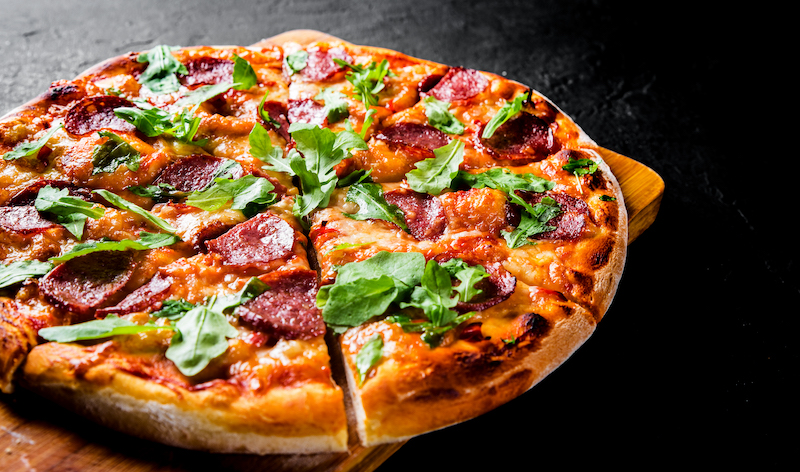
Getty Images
Brian: What about your least favorite ingredient?
Mario: The one I use the least has to be hot peppers. Crushed peppers. It’s one of my least favorite ingredients. If you completely want to destroy a dish, if you put too much of that in, you’re done. If it’s too spicy, you can’t taste anything else. I remember on Iron Chef, as a matter of fact, one of our contestants lost a battle because they put hot peppers everywhere. I thought, “You’re killing me. You made such an amazing dish, and you killed all the flavor.” So that’s my least favorite ingredient, together with garlic, for all the same reasons. If you use too much, then all you taste is garlic.
Brian: Is there any ingredient you have yet to taste or work with that you would like to try out?
Mario: I have tasted this ingredient, but I have yet to work with it: jicama. It looks like a potato, but it is definitely not a potato. It’s juicy, sweet and crunchy and is usually eaten raw. It has a very interesting flavor profile. There is a little hint of a carrot, but it is not a carrot, and some cucumber, but it is not a cucumber.
Brian: How important do you think it is for pizzerias to buy local ingredients?
Mario: It has to be done right. I’ve seen places that offer locally grown coconuts and pineapples in Illinois. I’m sorry, but those are not local ingredients and probably aren’t the best versions of that ingredient. Make sure it is a true, native ingredient and grown locally to ensure quality. Now, I have heard other people say they consider “locally grown” to be a 250-mile radius around Chicago. That’s just not that local to me. It is good to support the local community, but just be careful what you label “local ingredients” on your menu. I would say from the heart, please, let’s use products that are naturally grown and grown in season.

